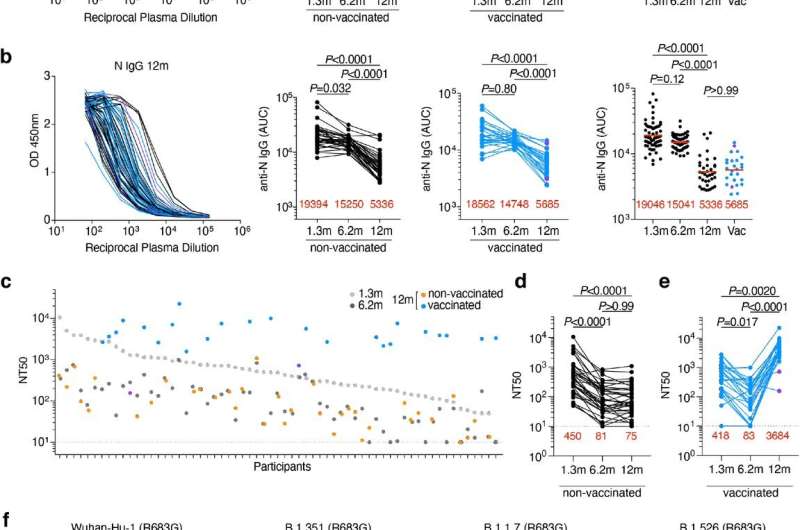Plasma ELISAs and neutralizing activity. a-b, Plasma IgG antibody binding to SARS-CoV-2 RBD (a) and N protein (b), and plasma neutralizing activity (c–e) 12 months after infection (N=63). a and b, ELISA curves from non-vaccinated (black lines) individuals, as well as individuals who received one or two doses of a COVID-19 mRNA vaccine (blue lines), respectively (left panels). Area under the curve (AUC) over time in non-vaccinated and vaccinated individuals, as indicated (middle panels). Two individuals who received their first dose of vaccine 24-48 hours before sample collection are depicted in purple. Lines connect longitudinal samples. Numbers in red indicate geometric mean AUC at the indicated timepoint. Right most panel shows combined values as a dot plot for all individuals. c, ranked average NT50 at 1.3 months (light grey) and 6.2 months (dark grey), as well as at 12 months for non-vaccinated (orange) individuals, and individuals who received one or two doses (blue circles) of a COVID-19 mRNA vaccine, respectively. Two individuals who received their first dose of vaccine 24-48 hours before sample collection are depicted in purple. d, e, NT50 over time in non-vaccinated (d) and vaccinated individuals (e). Lines connect longitudinal samples from the same individual. Two individuals who received their first dose of vaccine 24-48 hours before sample collection are depicted in purple. Red numbers indicate the geometric mean NT50 at the indicated timepoint. Statistical significance in a, b, d and e was determined using Friedman Multiple Comparisons test. f, Plasma neutralizing activity against SARS-CoV-2 variants of concern. All experiments were performed at least in duplicate.
According to new research, people who have had COVID enjoy strong immunity against the coronavirus for at least a year after they were initially infected. In analyzing antibodies present in the blood of COVID patients, Rockefeller scientists were able to track the evolution of these mutable molecules. They found that vaccination boosts the immunity these individuals naturally develop upon infection, so much that they are likely protected even from the emerging variants.
The 63 people in the study had COVID in the spring of last year. Data from their follow-ups show that, over time, antibodies produced by the immune system's memory B cells got better and better at neutralizing SARS-CoV-2, suggesting that these people were developing an improved, long lasting defense against the virus.
Moreover, the researchers found that these antibodies were further enhanced among 26 people in the group who had received at least one dose of the Moderna or Pfizer vaccine. This subset of people developed antibodies that are exceptionally resistant to the most concerning SARS-CoV-2 variants, such as those first isolated in the United Kingdom, South Africa, and New York City.
These potent antibodies are produced by groups of highly evolved memory B cells, which expand dramatically after a nudge by the vaccines, the team found.
The findings suggest that well-timed boosters with the current vaccines may provide additional protection in people who have never had the disease.
The study, carried out in the laboratories of Paul Bieniasz and Michel C. Nussenzweig, is available on bioRxiv ahead of publication in a peer-reviewed journal.
More information: Zijun Wang et al, Vaccination boosts naturally enhanced neutralizing breadth to SARS-CoV-2 one year after infection, bioRxiv (2021). DOI: 10.1101/2021.05.07.443175
Provided by Rockefeller University
























